Key takeaways:
- Dyslexia is a complex condition that affects academic performance and emotional well-being, necessitating tailored support and understanding.
- Effective communication, especially about assessment results, is crucial for fostering positive perceptions and empowering students and families.
- Utilizing visual aids can transform complex information into accessible narratives, enhancing engagement and understanding during discussions.
- Practicing empathy in conversations helps create supportive environments, fostering collaboration and improving outcomes for students and families.
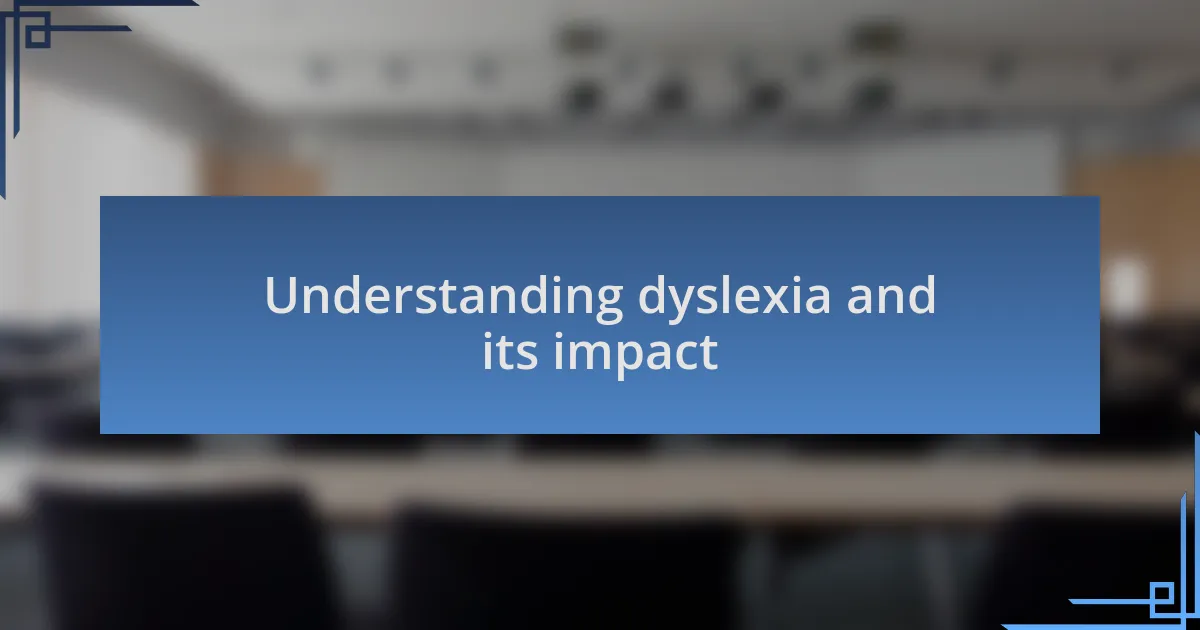
Understanding dyslexia and its impact
Dyslexia is not just about difficulty reading; it’s a complex neurological condition that can affect an individual’s academic performance and emotional well-being. I remember when a student of mine felt defeated by his challenges, often saying, “Why can’t I just read like everyone else?” This really struck me; it underscored the frustration and self-doubt that can accompany dyslexia, impacting not just learning, but also a person’s self-esteem.
The impact of dyslexia can extend beyond the classroom, influencing social interactions and personal relationships. I’ve seen students who struggle with these challenges also withdraw from activities they once loved, fearing judgment from peers. It raises an important question: how do we create an environment that fosters understanding and support, rather than stigma?
Understanding dyslexia means recognizing that it involves diverse challenges, like difficulties with phonemic awareness and processing speed. From a personal perspective, I’ve seen how essential it is for children to receive tailored support that not only addresses their academic needs but also nurtures their confidence. It’s heartbreaking to watch a bright mind get overshadowed by the hurdles dyslexia can create, but with the right strategies, I have also witnessed incredible transformations.
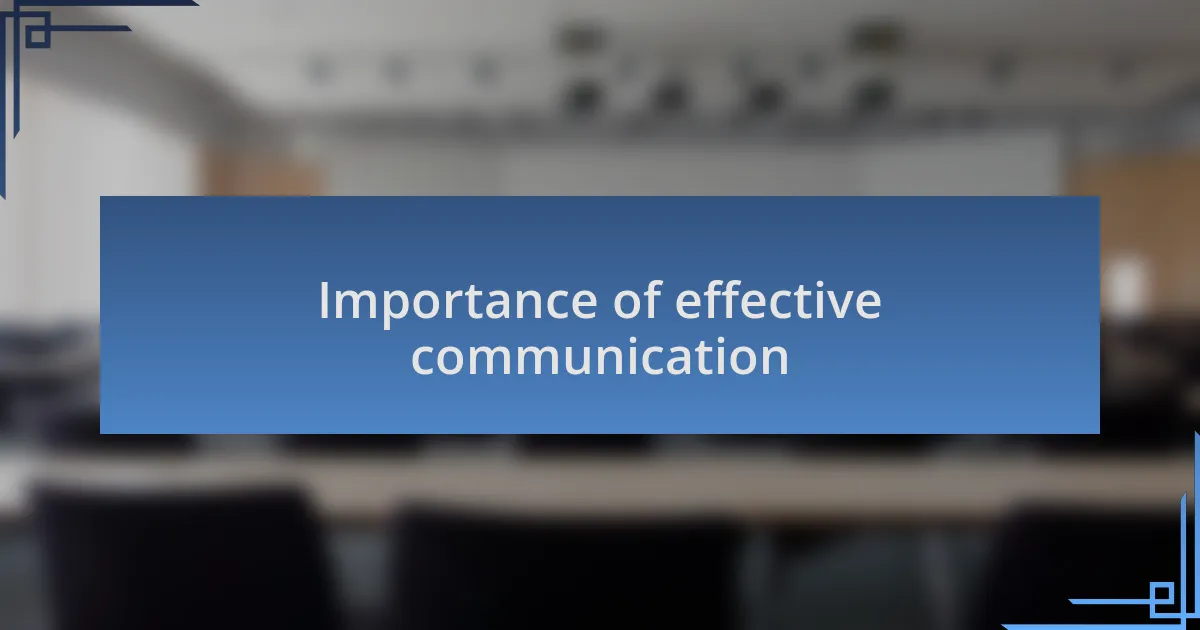
Importance of effective communication
Effective communication is crucial, especially when it comes to sharing assessment results with students and their families. I recall a parent who was relieved yet confused after receiving her child’s evaluation. She appreciated the insights but struggled to understand the implications for her child’s future. This experience taught me that clarity is vital; without it, even the most helpful information can feel overwhelming and lead to anxiety.
When we communicate assessments, we are not just delivering results; we are shaping perceptions and possibilities. I’ve had moments when I shared progress with students, celebrating their growth in a way that excited them. They sparked new ambitions in those discussions, and it was clear that a positive, open dialogue could turn a daunting diagnosis into a stepping stone toward success. How can we ensure that our words empower rather than discourage?
Moreover, fostering an environment of effective communication allows us to tailor our approaches to individual needs. I often reflect on a particular student who thrived when we set collaborative goals during our discussions. Those conversations didn’t just inform; they engaged her in her own learning process. It reinforced the idea that communication is not one-way; it’s a partnership that invites everyone into the journey of overcoming challenges together.
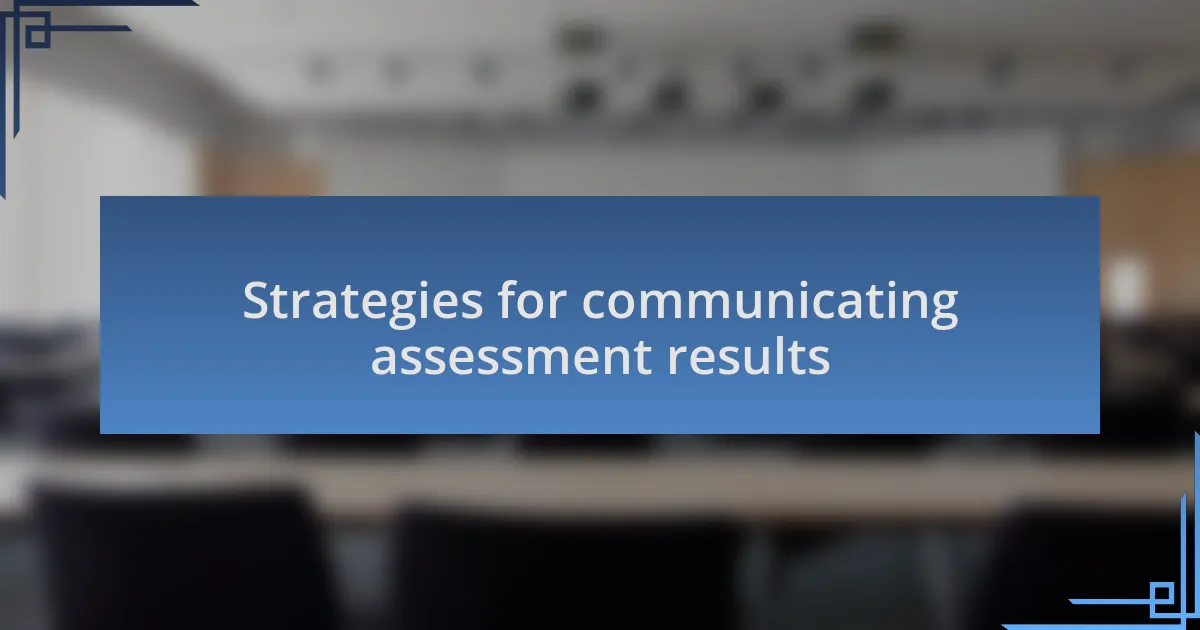
Strategies for communicating assessment results
One effective strategy I’ve found is to break down assessment results into relatable components. For instance, when explaining a student’s reading levels, I often use age-appropriate comparisons that resonate with their experiences. Last year, I described reading milestones by relating them to favorite books, which not only piqued their interest but also made the information more accessible. Have you ever noticed how a simple analogy can create that “aha” moment?
Another approach involves inviting families into the conversation. I remember a particularly enlightening meeting with a parent where we collaboratively discussed a child’s assessment results. Instead of merely presenting data, I engaged her in a dialogue, asking about her observations at home. Together, we explored strategies tailored to her child’s strengths and challenges, fostering a collaborative spirit. This experience underscored the notion that nurturing a two-way dialogue can transform daunting assessments into shared goals.
Visual aids can also be a game changer in conveying assessment results effectively. I frequently employ charts or graphics to illustrate progress over time, which I find captivates my audience. During one session, I used a colorful progress chart with smiley faces to depict improvement in a student’s reading. The joy on that child’s face was unforgettable, and it reinforced my belief that visuals can simplify complex information. Isn’t it fascinating how a little creativity can bridge gaps in understanding?

Tailoring communication for different audiences
Understanding your audience makes a significant difference in how assessment results are communicated. For example, when I present to educators, I dive deeper into the data analytics and methodologies behind the assessments. However, in discussions with students, I focus on the emotions connected to their learning journeys. I often ask them how they feel about their progress, inviting them to express their thoughts—have you ever realized how powerful self-reflection can be in boosting a child’s confidence?
When I’m discussing results with school administrators, I prioritize clarity and actionable insights. During one recent meeting, I tailored my presentation to fit their strategic goals, connecting individual student outcomes to classroom performance metrics. The room buzzed with excitement as we brainstormed new initiatives; it was a reminder that when communication is relevant, it can spark innovation and drive change. Doesn’t it feel rewarding when your words lead to tangible solutions?
In one-on-one sessions with parents, I find that empathy plays a crucial role. I remember a heartwarming conversation with a mom who felt overwhelmed by her child’s struggles. I shared success stories from other families who had navigated similar challenges. By highlighting resilience and progress, we turned what could have been a moment of despair into a celebration of potential and hope. How does it feel to know that with the right words, you can empower someone to see a brighter future?
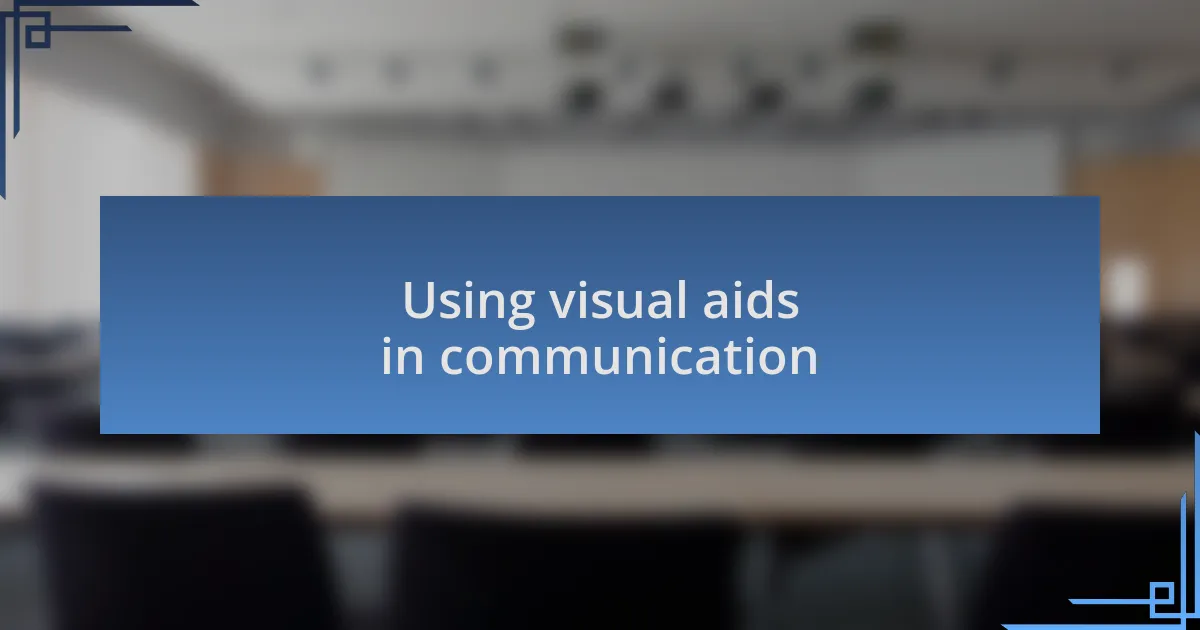
Using visual aids in communication
When I incorporate visual aids into my communication, I notice a remarkable shift in engagement. For instance, I once used colored charts to illustrate reading progress to a group of parents. It was fascinating to see how their eyes lit up as the visuals transformed abstract data into a tangible narrative. Have you ever seen how a simple graph can turn confusion into clarity?
In my experience, visuals can break down complex information into digestible pieces, especially for individuals with dyslexia. I remember a session where I utilized diagrams to explain phonemic awareness. The parents seemed relieved, as the images helped them visualize concepts that had previously felt overwhelming. How often do we underestimate the power of a well-placed image?
Furthermore, I find that using videos can be especially beneficial during professional development workshops. I once shared a short clip that depicted a successful classroom intervention for dyslexic students. The immediate reactions were priceless; it was as though a light bulb went off for many attendees. Isn’t it amazing how visual storytelling can make lessons stick and inspire action?
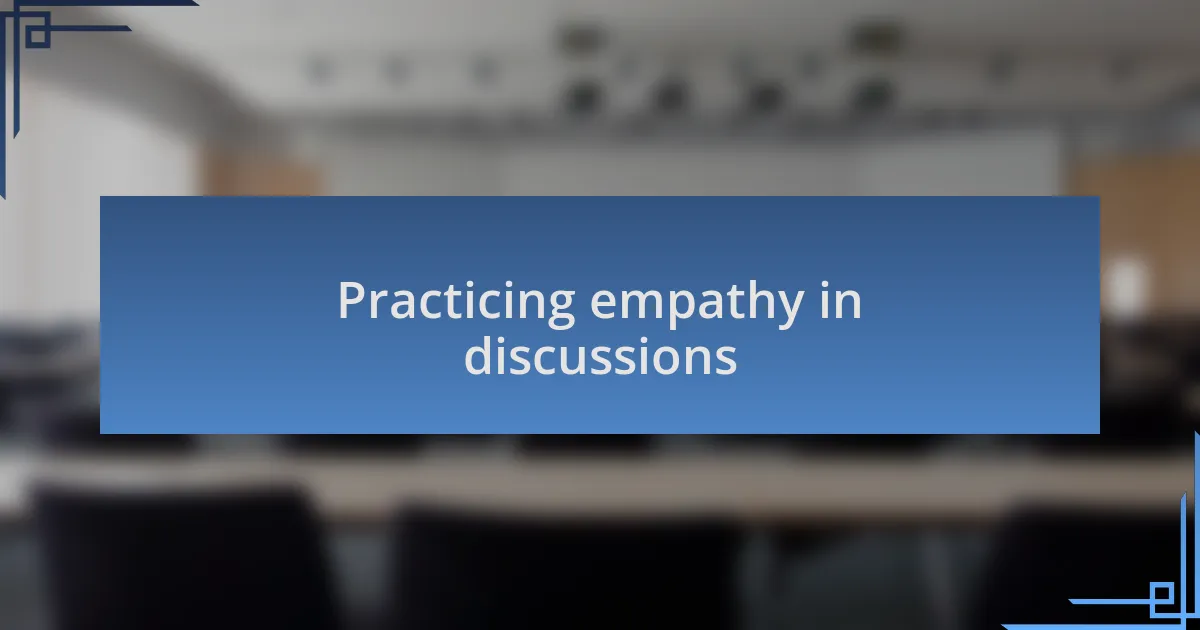
Practicing empathy in discussions
Practicing empathy in discussions is crucial, especially when talking about sensitive subjects like assessment results. I recall a recent meeting where I shared assessment scores with a parent who was visibly distressed. By taking a moment to acknowledge their feelings, I was able to create a supportive atmosphere, allowing us to discuss solutions rather than dwelling on the numbers. Have you ever noticed how simply validating someone’s emotions can open new pathways for communication?
Empathy allows us to connect on a deeper level. I’ve learned that by listening first, rather than rushing to present findings, I can better understand the concerns and hopes of those I’m speaking with. In one instance, a parent expressed fears about their child’s future based on their assessment. By recognizing their anxiety and addressing it directly, we were able to craft an action plan that felt collaborative. How often do we stop to truly listen before we speak?
Moreover, practicing empathy involves being mindful of our language and tone. I’ve made it a point to use supportive phrases like “I understand” and “It’s okay to feel overwhelmed” during difficult conversations. These small adjustments in my approach have consistently led to more productive discussions. What if making someone feel heard was the key to turning a challenging conversation into a positive experience?

Seeking feedback for improvement
Seeking feedback is a powerful way to enhance our communication strategies. I remember one time asking a parent to share their thoughts after we discussed their child’s assessment results. They offered insights that completely reshaped my approach for future conversations, helping me understand what truly resonated with them. Have you ever thought about how others perceive your communication?
When I actively seek feedback, it not only improves my methods but also makes the parents feel more involved in the process. After a meeting, I often follow up with a brief survey or a casual chat to gauge their comfort level and understanding of what was shared. This additional step has led to deeper conversations and clarified misunderstandings I didn’t even recognize before. How do you ensure you’re addressing the real concerns of the people you work with?
Additionally, not all feedback is positive, and that’s okay. I once received constructive criticism from a colleague who pointed out that I sometimes used jargon that confused parents. Adapting my language not only made our discussions clearer, but it also improved my relationships with families. Have you considered how feedback can serve as a catalyst for growth in your communication style?